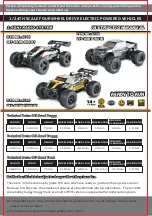
SETUP ANLEITUNG
SETUP GUIDE
Bodenfreiheit
Die Bodenfreiheit des Chassis hat großen Einfluss darauf, wie das Auto mit dem Untergrund zurecht kommt. Ein Glatt-
bahnfahrzeug hat weniger Bodenfreiheit (ca. 5–6mm) als ein Offroad Fahrzeug (ca. 20-30mm). Einstellbar ist die Boden-
freiheit über die Unterleg Clipse an den Stoßdämpfern. Durch unterschiedliche Einstellung von Vorder- und Hinterachse
kann das Fahrverhalten ebenfalls beeinflusst werden. Optimal ist es, vorne und hinten die gleiche Höhe zu haben.
Adjusting the ride height
The ride height of the chassis will greatly influence how the vehicle handles the surface it is being used on. An onroad
car has less ride height (round about 5-6mm) than an off road car (round about 20-30mm). You can adjust the ride height
on your vehicle by using the preload collar on the shock absorber body. Make sure you add the same distance of the
adjustment screw on each side as unequal left to right ride height will result in inconsistent performance. You can adjust
the front and rear ride height independently which will also alter the handling characteristics. It is best to have equal
front and rear ride height.
Dämpferpositionen
Sie können die Winkel der Dämpfer, sowie die Entfernung zur Mittelachse des Chassis ändern, indem Sie sie an unter-
schiedlichen Punkten der Dämpferbrücken und der Querlenker befestigen.
Flachere Dämpferpositon
(Dämpfer an der Brücke weiter innen, an der Schwinge weiter außen):
Weichere Dämpfung, bessere Seitenführung, geeignet für griffige Stre-
cken, Fahrzeug fährt stabiler und einfacher.
Steilere Dämpferposition
(Dämpfer an der Brücke weiter außen, am Querlenker weiter innen):
Härtere Dämpfung bewirkt ein direkteres Fahrverhalten, gut geeignet für
enge, technisch anspruchsvolle Strecken.
Shock mounting Position
You can change the shock mounting position by mounting the shocks at
different angles, and also moving the shock closer or further from the cen-
terline of the car. You accomplish this by moving the shock top and bottom mounts to different locations on the shock
towers and lower suspension arms.
More angled shocks (less upright), moving in on tower and/or moving out on lower arm.
Softer initial damping, makes the handling more “forgiving”, good for high-bite tracks, since it makes the car more stable
and easy to drive.
Less angled (shocks more upright). Moving out on tower and/or moving in on the lower arm.
Stiffer dampening, makes the handling more responsive, better suited for tight, technical tracks.
P. 49














































